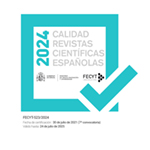Soria 3: nuevas evidencias de la ocupación aldeana temprana en Yocavil, Noroeste argentino. Un ejercicio interpretativo
Resumen
Se presentan evidencias estratigráficas provenientes de un sondeo localizado en el interior de una estructura semicircular con muros de piedra, sitio denominado Soria 3, correspondiente al período Temprano (600 a.C.-1000 d.C.) del Noroeste argentino. La unidad, registrada en la Terraza de Andalhuala Banda (Valle de Yocavil, Provincia de Catamarca), se interpretó como una unidad residencial empleada, luego de su desocupación, como espacio funerario para el entierro de un infante en una olla. Se detallan las características constructivas de la estructura, la estratigrafía y los materiales recuperados, la modalidad de inhumación, el contenedor cerámico empleado para la misma y los resultados del análisis bioarqueológico de los restos óseos. Asimismo, se comunican las dataciones radiocarbónicas obtenidas a partir de muestras del individuo y carbones del piso de ocupación del espacio doméstico. Las evidencias son coherentes con el patrón de ocupación previamente registrado en el sitio Soria 2, unidad doméstica emplazada en la misma terraza, apuntando a la configuración de un patrón aldeano local.Descargas
Descarga artículo
Licencia
La Revista Española de Antropología Americana, para fomentar el intercambio global del conocimiento, facilita el acceso sin restricciones a sus contenidos desde el momento de su publicación en la presente edición electrónica, y por eso es una revista de acceso abierto. Los originales publicados en esta revista son propiedad de la Universidad Complutense de Madrid y es obligatorio citar su procedencia en cualquier reproducción total o parcial. Todos los contenidos se distribuyen bajo una licencia de uso y distribución Creative Commons Reconocimiento 4.0 (CC BY 4.0). Esta circunstancia ha de hacerse constar expresamente de esta forma cuando sea necesario. Puede consultar la versión informativa y el texto legal de la licencia.









